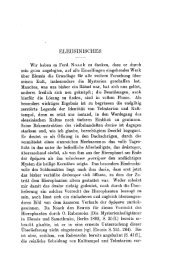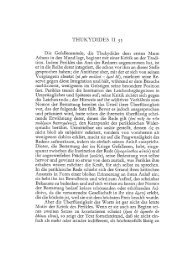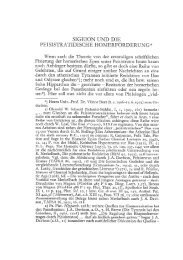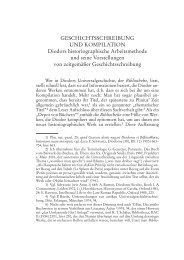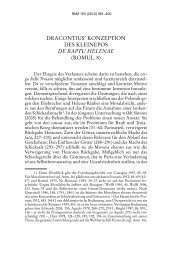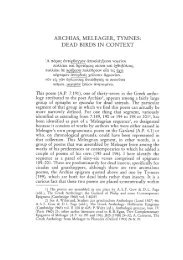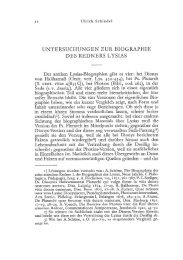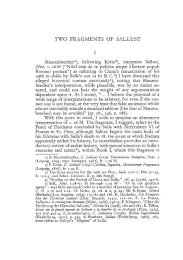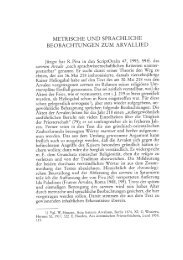APOTELESMATICA 2. (1) 14–140: SOURCES AND MODELS*
APOTELESMATICA 2. (1) 14–140: SOURCES AND MODELS*
APOTELESMATICA 2. (1) 14–140: SOURCES AND MODELS*
Create successful ePaper yourself
Turn your PDF publications into a flip-book with our unique Google optimized e-Paper software.
96 Maria Ypsilanti<br />
ed the temoËsa of the codex (if Koechly reports accurately the<br />
reading of the manuscript, the rare in poetry Attic aorist participle<br />
temoËsa [�temon] is almost surely a mistake, as we should have<br />
the epic [and also generally used] participle tamoËsa) to kamoËsa<br />
because not only is this adjective far more appropriate for the description<br />
of the construction of an artefact in this phrasing and syntax,<br />
76 but is actually repeatedly used by Apollonius on the same<br />
subject (cf. 1.111 aÈtØ går ka‹ n∞a yoØn kãme, 3.340 n∞a dÉ ÉAyhna¤h<br />
Pallåw kãmen). Apot. <strong>2.</strong> (1) 104 f. is thus a playful combination<br />
with variation of these passages and Ap. Rh. <strong>2.</strong>1187 f. tØn går<br />
ÉAyhna¤h texnÆsato ka‹ tãme xalk“ / doÊrata Phliãdow koruf∞w<br />
pãra.<br />
In its normal Homeric sedes is also êcorrow in the description<br />
of the constellations of the Galaxy (l. 125): the variation in regard<br />
to tradition lies here in that it is the adverb êcorron that usually<br />
occupies the verse-opening in Homer. 77 The epic tone rings<br />
through the lines in the account about the Meridian (ll. 109–11); 78<br />
±–hn o‰mon (l. 110) further seems a variation of the Homeric formula<br />
about water and air, Ígrå k°leuya, Il. 1.312, Od. 3.71, 4.842,<br />
al., ±erÒenta k°leuya, Od. 20.64.<br />
It should not go unattended, in this discussion, that Manilius<br />
is occasionally echoed in the text of Pseudo-Manetho. In an instance<br />
of his account of the Meridian (ll. 110 f.), the author takes<br />
up Manilius’ discernit diem (1.635). Interesting is also Apot. <strong>2.</strong> (1)<br />
73, which opens the account about the Tropic of Cancer, with<br />
Olympus indicating the sky, as often in Manilius, 79 also at verseend;<br />
the image moreover recalls Man. 1.576 ingenti spira totum<br />
76) There is no reference to the trees which could be ‘cut’ by Athena, to justify<br />
the use of t°mnein, and this verb cannot be forced to mean ‘make’, as if it were<br />
kãmnein: meaningless is the rendering of Koechly (1851): “et gubernaculum navis,<br />
quam summis secans / Pelii in verticibus Minerva posuit in stellis Argo”. Salvini (39)<br />
renders “ed il timone della nave / cui di Pelio tagliando dalla cima, / Argo, Pallade<br />
pose infra le stelle” as if the text had §k koruf∞w, which is Gronovius’ reading, and<br />
so probably indeed the reading of the transmitted text, but seems to be rightly corrected<br />
by Koechly to §n korufa›w. Likewise the ékrotÒmoisi that is the reading of<br />
Gronovius, and also presumably that of the codex, is most probably rightly corrected<br />
to ékrotãt˙si.<br />
77) Il. 4.152, 7.413, 1<strong>2.</strong>74, 16.376, 21.382, Od. 10.558, 11.63.<br />
78) Cf. Il. 21.111 ssetai μ ±Δw μ de¤lh μ m°son ∑mar, Hes. Op. 404 xrei«n<br />
te lÊsin, ibid. 810 efinåw dÉ ≤ m°ssh §p‹ de¤ela l≈ion ∑mar. Cf. Kidd on Arat. 118.<br />
De¤elon in Pseudo-Manetho (l. 110) occurs at the Hesiodic sedes.<br />
79) For instance 1. 576, [595], 609, 634, 711, al.



